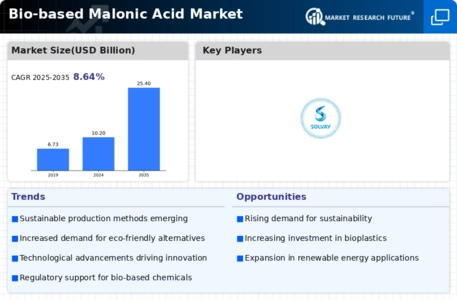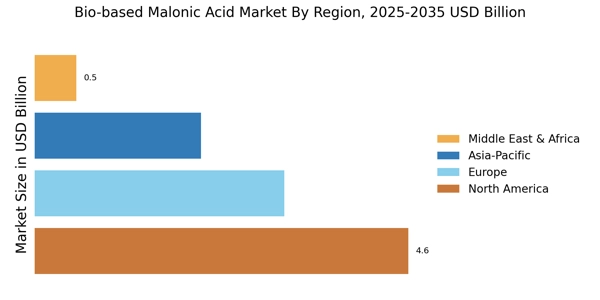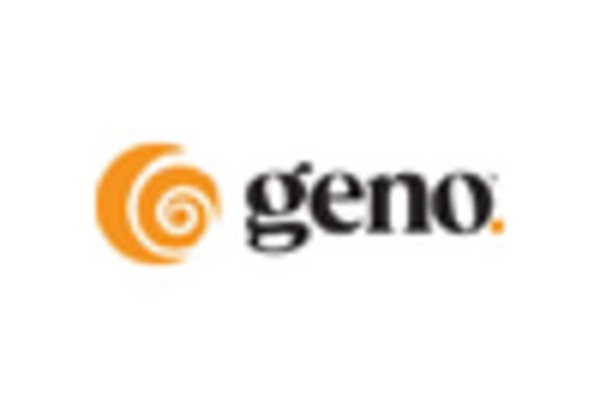Consumer Awareness and Education
Consumer awareness regarding the benefits of bio-based products is a crucial driver for the Bio-based Malonic Acid Market. As consumers become more educated about the environmental impacts of their choices, there is a growing demand for products that are derived from renewable resources. This shift in consumer behavior is prompting manufacturers to highlight the sustainability aspects of their products, including those containing bio-based malonic acid. Educational campaigns and marketing strategies focused on the advantages of bio-based chemicals are likely to further enhance consumer acceptance and preference. Market trends suggest that as awareness increases, the demand for bio-based malonic acid will continue to rise, encouraging manufacturers to innovate and expand their product offerings in response to this evolving consumer landscape.
Supportive Regulatory Frameworks
The Bio-based Malonic Acid Market benefits from an increasingly supportive regulatory environment aimed at promoting sustainable chemical production. Governments across various regions are implementing policies and incentives to encourage the use of bio-based materials, which are often viewed as more environmentally friendly compared to their petroleum-based counterparts. For instance, regulations that mandate the reduction of greenhouse gas emissions are pushing industries to adopt bio-based alternatives. This regulatory support not only fosters innovation but also creates a favorable market landscape for bio-based malonic acid. As a result, companies are more likely to invest in the development and commercialization of bio-based malonic acid, anticipating compliance with future regulations and capitalizing on potential market opportunities.
Rising Demand for Eco-friendly Products
The increasing consumer preference for sustainable and eco-friendly products is a primary driver for the Bio-based Malonic Acid Market. As awareness of environmental issues grows, industries are shifting towards bio-based alternatives to reduce their carbon footprint. This trend is particularly evident in sectors such as pharmaceuticals, food additives, and biodegradable plastics, where bio-based malonic acid serves as a key ingredient. Market data indicates that the demand for bio-based chemicals is projected to grow at a compound annual growth rate (CAGR) of over 10% in the coming years, reflecting a significant shift towards sustainable practices. Consequently, manufacturers are investing in bio-based malonic acid production to meet this rising demand, thereby enhancing their market presence and contributing to a more sustainable future.
Technological Innovations in Production
Technological advancements in the production of bio-based malonic acid are significantly influencing the Bio-based Malonic Acid Market. Innovations in fermentation technology and synthetic biology are enabling more efficient and cost-effective production processes. For example, recent developments in microbial fermentation techniques have improved yield rates and reduced production costs, making bio-based malonic acid more competitive against traditional petrochemical methods. Market analysis suggests that these technological improvements could lead to a reduction in production costs by up to 30% over the next few years. As production becomes more efficient, manufacturers are likely to increase their output, thereby expanding the market for bio-based malonic acid and meeting the growing demand from various end-use industries.
Expanding Applications Across Industries
The versatility of bio-based malonic acid is driving its adoption across a wide range of applications, thereby propelling the Bio-based Malonic Acid Market. This compound is utilized in various sectors, including pharmaceuticals, agrochemicals, and food additives, due to its functional properties. For instance, in the pharmaceutical industry, bio-based malonic acid is used as a building block for the synthesis of active pharmaceutical ingredients. Additionally, its application in the production of biodegradable plastics is gaining traction as industries seek sustainable alternatives. Market data indicates that the use of bio-based malonic acid in these applications is expected to grow, with a projected increase in demand from the agrochemical sector alone estimated at 15% over the next five years. This expanding application base is likely to enhance the market dynamics for bio-based malonic acid.





















Leave a Comment